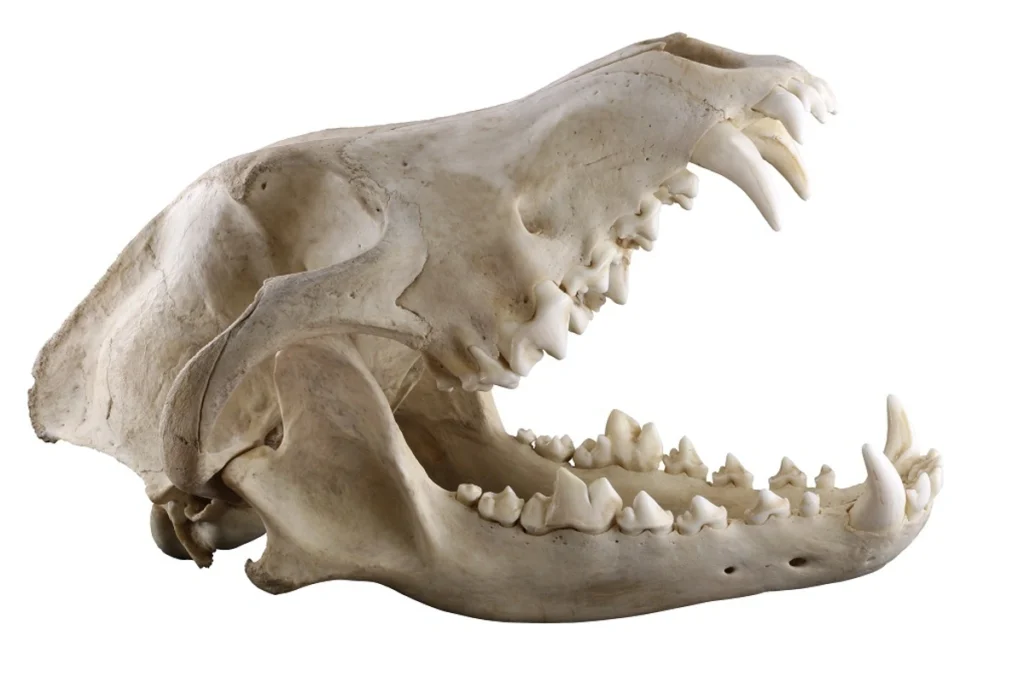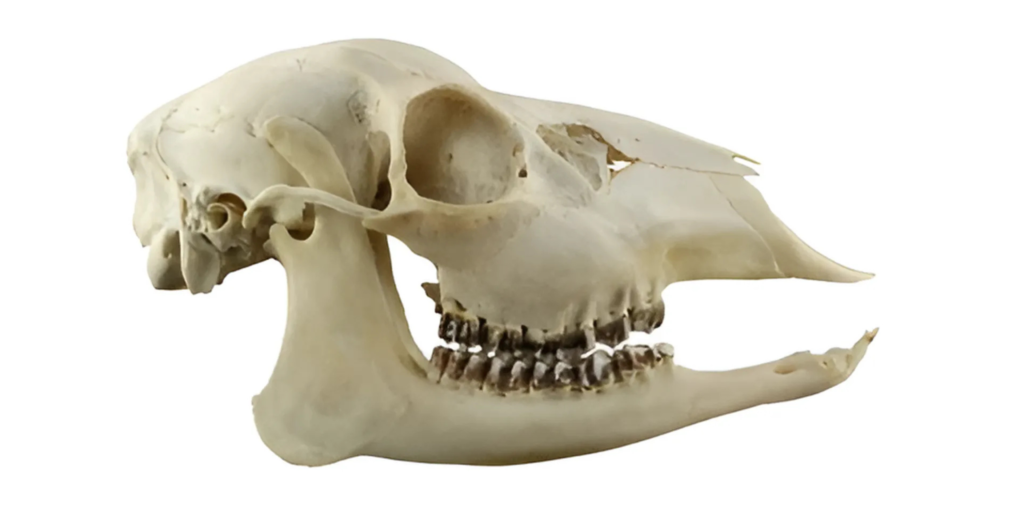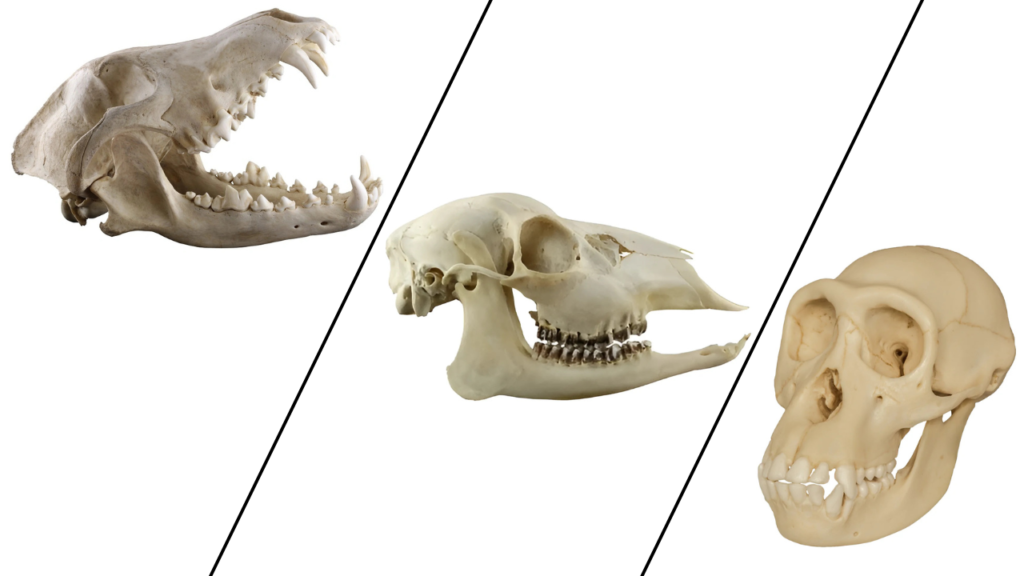Looking for a simple way to understand and identify skulls?
Identifying Animal Skulls: The Three Main Groups
Skulls can be classified into three primary groups based on their diet: carnivores, herbivores, and omnivores. Each group has specific features in the shape, structure, and teeth that are adapted to their unique nutritional needs. It is important to understand how each group’s diet has affected the development of their skulls and teeth. The shape of the jaw, size, and shape of the teeth, and even the placement of eye sockets all provide clues about what an animal eats. Understanding these differences helps us identify greatly!
Now, let’s look at this three groups to understand more thoroughly
The three main groups (⬇️)

1. Carnivores
Carnivores are animals that primarily eat meat. A carnivore’s skull is adapted for hunting and consuming prey. One of the most recognizing features of a carnivore’s skull is its incredible sharp, pointed canine teeth. These teeth are used to puncture and hold onto their prey. Carnivores have large, well-developed canine teeth for this purpose. Their molars are often shaped, being specifically used for shearing, enabling them to cut through muscle and bone. Their eye sockets, located towards the front of the skull, provide what is known as binocular vision, which allows them to have depth perception. This is crucial when hunting for food. Carnivores also generally have strong jaw muscles and short, powerful jaws to aid in acquiring and defeating their prey.

2. Herbivores
Herbivores are animals that eat plant material. Herbivores have skulls designed for grinding and chewing tough vegetation. The difference to carnivores, herbivores have large, flat molars with ridged surfaces that help grind tough plants, which are hard to digest. Their incisors (which are pointy and sharp teeth), are located in the front of their mouth, they are sometimes used for cutting, while in animals like cows and horses, their canine teeth are either small or nonexistent. The eye sockets in herbivores skulls are positioned on the sides of the head, providing a wide field of vision to help detect predators. carnivores also tend to have longer skulls with larger jaws and jaw muscles, adapted for the continuous chewing that their diets require.

3. Omnivores
Omnivores have a more generalized skull structure, as they consume both plant and animal matter. Their teeth are a blend of sharp canines, for occasional eating meat, and flat molars for grinding plants, showing the variety in their diet. Animals like bears, raccoons, and humans are all omnivores. Omnivores have a position of the eye sockets that allows them to have wider field of vision while still offering some depth perception. This skull structure enables them to adjust to a variety of food sources, which can be beneficial for survival in all environments.

In conclusion, by observing the skulls of carnivores, herbivores, and omnivores, we can gain a deeper understanding of the mix between form and function in the animal kingdom. It is truly incredible to see God’s hand in the creation of animals, putting over 100% effort in the intricate design of these creatures. While to the world we came from apes, we know through God’s word that we are different than any other kind. God created us more intelligent and complexed than any other, giving us a soul and a freedom to serve him. His beautiful creation makes it all so easier to serve him. In all, I hope you learned a lot about skull identification, and I hope you enjoyed!
Interesting read! I never realized how much the shape of an animal’s skull can reveal about its diet and lifestyle. The adaptations in carnivores, like their sharp canines and forward-facing eye sockets, make perfect sense for hunting, but I’m curious—how do herbivores’ skulls evolve to protect themselves from predators while focusing on chewing tough plants? It’s fascinating how nature tailors each species so precisely. Do you think omnivores have the most versatile skull structures since they need to handle both meat and plants? Also, are there any exceptions to these classifications where an animal’s skull doesn’t quite fit its expected diet? I’d love to dive deeper into this topic—what other factors influence skull evolution besides diet?
Wir haben libersave in unser regionales Gutscheinsystem eingebunden. Es ist toll, wie einfach man verschiedene Anbieter auf einer Plattform bündeln kann. Whith regards, EURST
This is truly fascinating! I never fully realized how much the shape of a skull and teeth can tell us about an animal’s diet and lifestyle. The adaptations of carnivores for hunting, like their sharp canines and binocular vision, seem so efficient for their survival. Similarly, the herbivores’ flat molars and side-positioned eyes make perfect sense for their need to grind plants and stay alert for predators. However, I wonder how omnivores fit into this classification—do they have a mix of these features, or is there another unique adaptation altogether? Also, are there any exceptions to these general rules where an animal’s skull doesn’t align with its diet? This makes me curious about how environmental factors might have influenced these evolutionary changes over time. What do you think?
Wir haben libersave in unser regionales Gutscheinsystem eingebunden. Es ist toll, wie einfach man verschiedene Anbieter auf einer Plattform bündeln kann. Whith regards, SPAYZ
It’s fascinating how skulls are so intricately designed to match an animal’s diet! The adaptations for carnivores, herbivores, and omnivores are so specific and purposeful—like the sharp canines for hunting or the flat molars for grinding plants. I wonder, though, how these features evolved over time to become so perfectly suited to their diets. Do you think there’s a universal starting point for all skull structures, or did they diverge completely based on dietary needs? Also, how do omnivores balance both features? Their skulls must be a real jack-of-all-trades! What’s your take on which group has the most “efficient” skull design? By the way, have you noticed if smaller animals within these groups show the same distinct features as larger ones?
P.S. We’ve integrated libersave into our regional voucher system. It’s amazing how easily it brings together different providers on one platform! Whith regards, PAYME